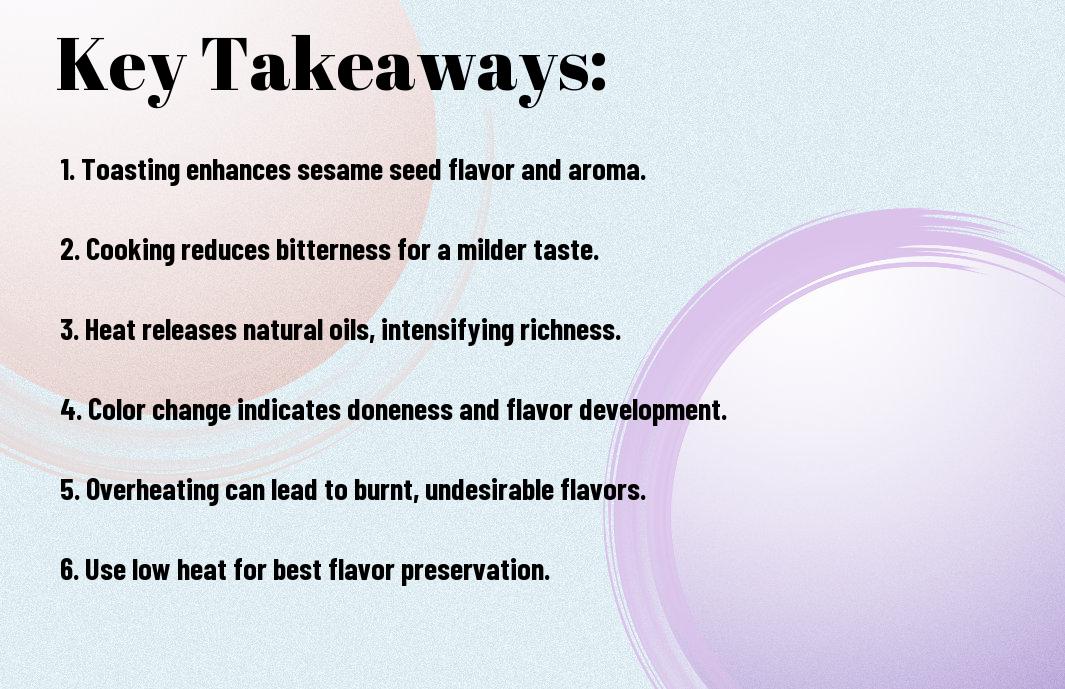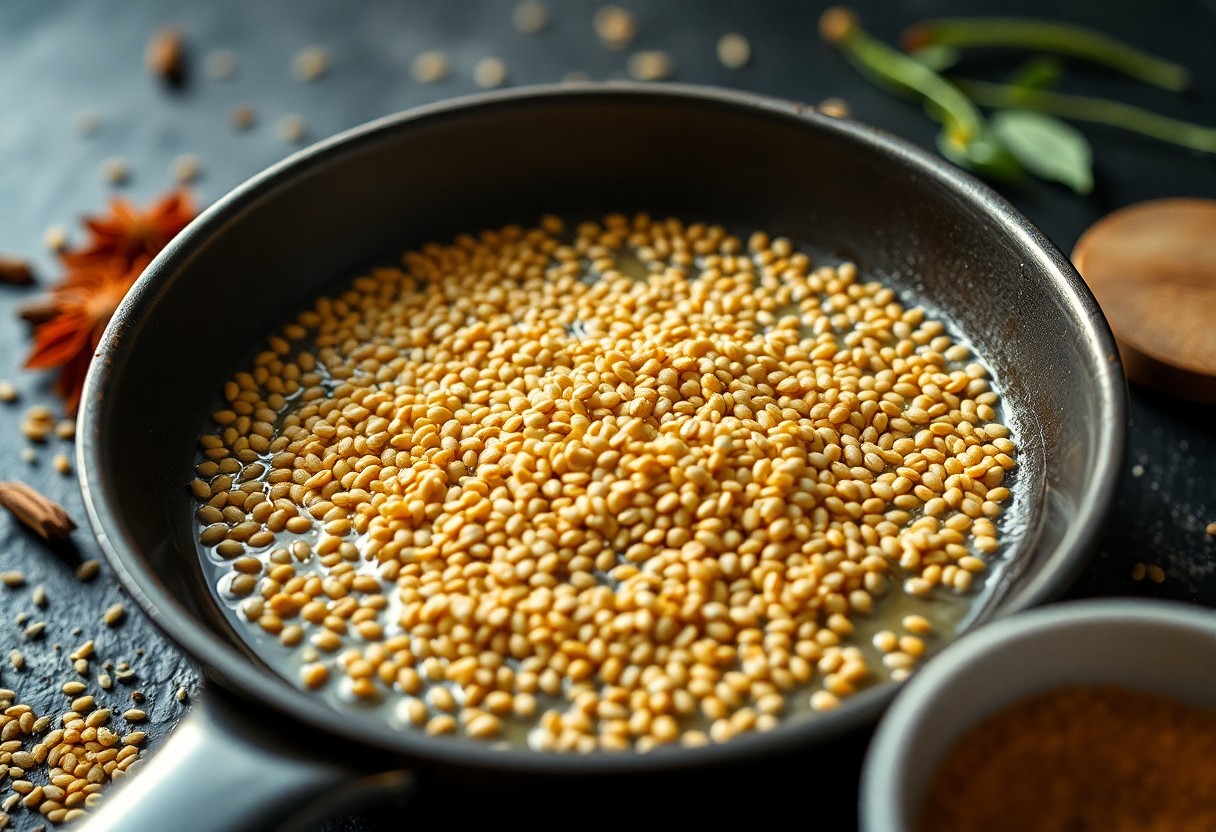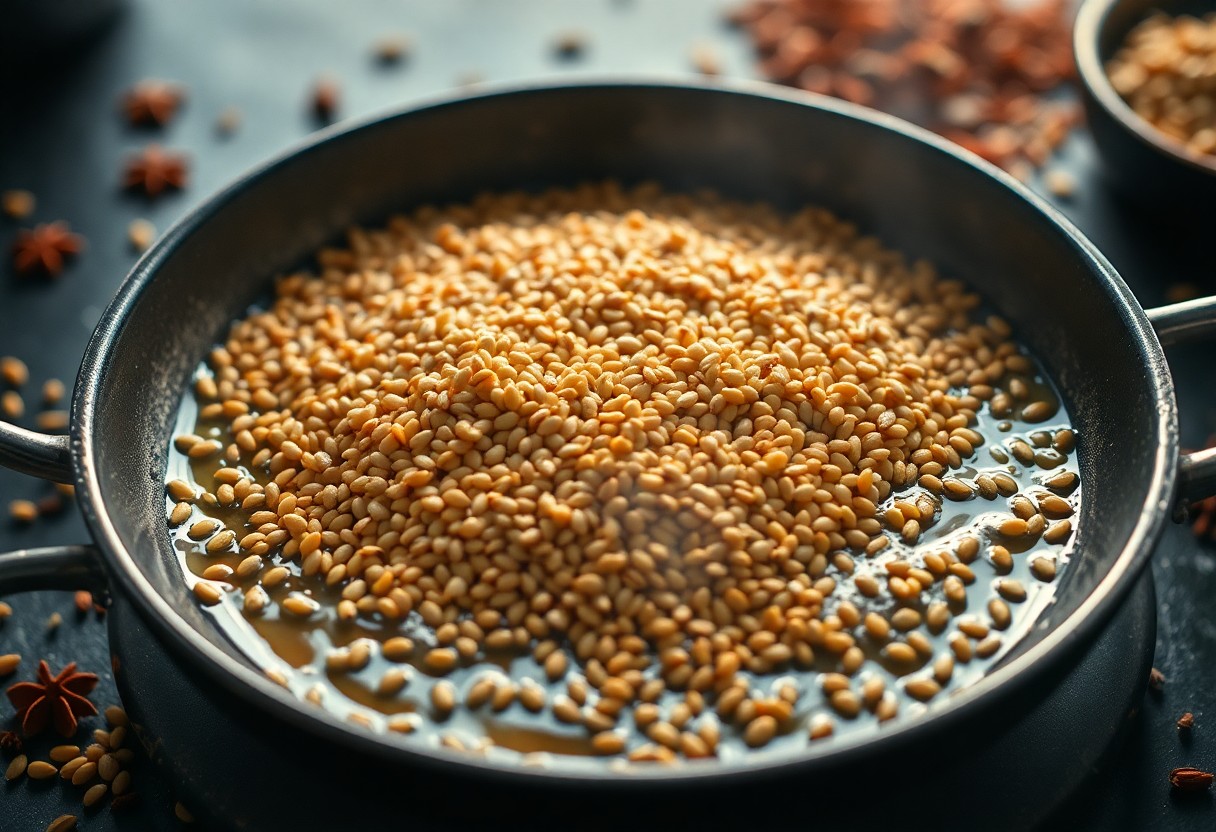Flavor is transformed when you cook sesame seeds, drastically enhancing their natural profile. As you heat these tiny powerhouses, they undergo a remarkable toasting process that brings out their rich, nutty taste while reducing any potential bitterness. This process not only improves their aroma, making your dishes more enticing, but also alters their texture, adding a satisfying crunch. However, be mindful of cooking times, as overcooking can lead to an unpleasant, burnt flavor. Understanding how to cook sesame seeds can elevate your culinary creations and optimize their health benefits.
Key Takeaways:
- Cooking sesame seeds enhances their nutty flavor, making them more pronounced and toasty compared to raw seeds.
- The process of toasting sesame seeds reduces their natural bitterness, allowing for a smoother taste experience in dishes.
- Toasting sesame seeds can also change their texture, providing a satisfying crunch that complements various recipes.
The Nutritional Profile of Sesame Seeds
Your understanding of sesame seeds goes beyond flavor; their nutritional profile is impressive. Rich in important vitamins and minerals, they offer a variety of beneficial compounds. Packed with nutrients such as calcium, iron, magnesium, and B vitamins, sesame seeds can help support your overall health. Incorporating these tiny seeds into your diet not only adds a delightful crunch but also enhances your nutritional intake.
Vitamins and Minerals
The vitamins and minerals in sesame seeds play a significant role in promoting health. They are particularly high in calcium, which is vital for bone health, and iron, vital for maintaining healthy blood levels. Moreover, magnesium contributes to energy production and muscle function. These nutrients collectively support your immune system, enhance your metabolic processes, and play a part in numerous bodily functions.
Healthy Fats and Proteins
Nutritional benefits of sesame seeds also lie in their healthy fats and proteins. These seeds are abundant in polyunsaturated and monounsaturated fats, which are known to promote heart health. Furthermore, they offer a notable amount of plant-based protein, making them an excellent addition to vegetarian and vegan diets as they help support muscle repair and growth, and contribute to overall satiety.
Indeed, the presence of healthy fats, notably omega-6 fatty acids, in sesame seeds plays an important role in your diet. These fats can help reduce inflammation and are linked to improved cholesterol levels. Additionally, the plant-based protein content provides vital amino acids, making them a fantastic choice for filling your nutrient requirements without relying solely on animal products. This combination promotes a balanced diet and supports your fitness and health objectives.

The Science Behind Cooking Sesame Seeds
Some of the transformation that occurs when you cook sesame seeds involves chemical reactions that develop their flavor and texture. Cooking changes the physical and chemical properties of the seeds, leading to enhanced taste and aroma. When you apply heat, you initiate a series of reactions that not only alter the seeds’ composition but also unlock their natural oils, providing a richer and nutty flavor profile.
Maillard Reaction
By exposing sesame seeds to heat, you trigger the Maillard reaction, a complex chemical process between amino acids and reducing sugars. This reaction contributes significantly to the browning of the seeds, creating appealing flavors and aromas. The resulting taste is more complex and satisfying, allowing for a deeper culinary experience.
Flavor Compounds and Aroma Changes
Against conventional wisdom, it’s not just the act of toasting that impacts flavor; the heat release promotes the formation of various *volatile flavor compounds*. These compounds can alter the overall sensory experience of your dish and create a profound impact on how you perceive the food.
Plus, cooking sesame seeds leads to the emergence of *volatile flavor compounds* such as pyrazines and aldehydes, which enhance aroma and deepen the flavor profile. The transformed seeds develop a toasty, nutty flavor that elevates your dishes. Notably, these aroma changes can stimulate your appetite, enhancing the overall eating experience. However, be cautious as *overcooking* can lead to bitterness, detracting from the otherwise pleasant flavor profile—so a watchful eye is vital while cooking your sesame seeds.
Different Cooking Methods for Sesame Seeds
For those looking to enhance the flavor and texture of sesame seeds, exploring different cooking methods can yield delightful results. Each method brings a unique character to the seeds, making them a versatile ingredient in your culinary repertoire. Whether you toast, roast, or incorporate them into dishes, understanding each technique transforms how you enjoy sesame seeds.

Toasting
Around a medium heat, toasting sesame seeds can quickly elevate their flavor profile. By gently heating the seeds in a dry skillet, you will unlock their natural oils, producing a warm, nutty aroma. Keep stirring them continuously to ensure even toasting and prevent burning, maximizing their potential in both sweet and savory dishes.
Roasting
Roasting sesame seeds adds a deeper flavor complexity compared to toasting. You will typically do this at a lower temperature, allowing for a gradual caramelization of the oils. This slow process enhances the seeds’ inherent nuttiness, providing a rich taste that elevates your meals.
This method is particularly effective for achieving a balanced, robust flavor. As the seeds roast, the heat activates their natural oils, leading to a rich, crunchy texture that complements various dishes. Watch closely as they can burn quickly if left unattended; once you see a golden hue, remove them from the heat. Using roasted sesame seeds can add a fantastic touch to salads, stir-fries, or as a finish on your favorite dips.
Impact on Flavor: Raw vs. Cooked Sesame Seeds
Despite their small size, sesame seeds have a notable impact on flavor, with raw seeds offering a mild, slightly nutty taste while cooked seeds develop a richer, more intense flavor. When you roast sesame seeds, the Maillard reaction enhances their nuttiness and contributes a delightful crunch, making them a perfect ingredient for elevating various dishes. As you experiment with cooking techniques, you’ll discover how these transformations can elevate the overall flavor profile of your meals.
Taste Differences
Taste is where the transformation of sesame seeds is most evident. Raw sesame seeds present a bland, somewhat oily flavor, while roasted seeds deliver a deeper, toasty, and more complex profile. The slight bitterness found in raw seeds dissipates upon cooking, allowing you to experience their inherent nutty characteristics. This change not only adds depth but also enhances the overall sensory experience of your dishes.
Culinary Applications
After cooking sesame seeds, you can incorporate them into a variety of dishes, from salads and stir-fries to baked goods and snacks. They add texture and flavor, enhancing your culinary creations with both visual appeal and nutritious benefits. Whether you sprinkle roasted seeds on top of your favorite dish or blend them into sauces, their versatility will elevate your cooking.
Further, incorporating roasted sesame seeds into your meals brings numerous benefits. They can be used as a topping for salads and grain bowls, adding crunch and flavor. You can blend them into dressings for a nutrient boost or use ground roasted seeds in baking recipes, enhancing muffins and bread with their unique profile. Plus, sesame seeds are rich in healthy fats, fiber, and antioxidants, making them a nutritious addition to any diet. Their ability to complement both sweet and savory dishes means you’ll find endless ways to enjoy their deliciousness in your cooking.
Common Uses of Cooked Sesame Seeds
Not only do cooked sesame seeds enhance the flavor of dishes, but they also provide a delightful crunch and nutritional benefits. You can incorporate them into various cuisines, from Asian stir-fries to Mediterranean salads, making them a versatile ingredient. Additionally, their toasted flavor profile can elevate simple dishes, adding depth and richness that everyone will enjoy.
In Dishes and Recipes
One great way to use cooked sesame seeds is in your stir-fries, soups, and even baked goods. Their nutty scent and flavor are perfect for enhancing sauces, marinades, and dressings, providing a tasty boost to your culinary creations.
As Garnishes and Toppings
Above all, cooked sesame seeds serve as excellent garnishes and toppings. They can be sprinkled over rice, noodles, or salads, adding a visually appealing touch along with their delightful crunch.
Recipes featuring cooked sesame seeds can dramatically change your presentation and flavor palate. You might sprinkle them on avocado toast for an added texture, add them to hummus to intensify its nutty undertones, or use them as a topping for grilled meats to create a blistering finish. Their versatility allows you to experiment with different dishes, enhancing every bite with their unique roasted flavor.

Storing Cooked Sesame Seeds
After cooking sesame seeds, it’s imperative to store them properly to maintain their flavor and texture. Allow the seeds to cool completely before transferring them to an airtight container to prevent moisture buildup. Keeping them in a cool, dry place will help preserve their quality, enabling you to enjoy their nutty flavor in future dishes.
Best Practices
With proper storage techniques, you can extend the life of your cooked sesame seeds. Always use airtight containers and avoid exposure to light and humidity. It’s also beneficial to keep them in the refrigerator if you intend to store them for more than a few days, ensuring they remain fresh and flavorful.
Shelf Life and Freshness
Below optimal conditions, cooked sesame seeds can last up to a week in the refrigerator. However, their freshness may degrade after just a few days, so it’s imperative to check for any off smells or changes in texture before using them.
For instance, when you store your cooked sesame seeds in the refrigerator, you may find they maintain their flavor for about 5 to 7 days. After this period, the seeds can begin to develop a rancid smell due to the fats in them oxidizing. To avoid any unpleasant surprises, always inspect for signs of spoilage such as an off odor or off-color appearance before consumption. Ensuring proper storage will keep your sesame seeds flavorful and safe to eat.
Summing up
Presently, understanding how cooking sesame seeds transforms their flavor is necessary for enhancing your culinary creations. When you toast or sauté them, their natural oils are released, leading to a nuttier and richer taste profile that can elevate both sweet and savory dishes. By experimenting with different cooking techniques and durations, you can discover the perfect balance of flavor that complements your meals. Incorporate toasted sesame seeds into your recipes to enjoy their delightful crunch and enhanced taste, making your dishes more appealing and satisfying.
FAQ
Q: What happens to sesame seeds when they are cooked?
A: Cooking sesame seeds causes them to release their natural oils, leading to a richer and more intense flavor. This process can enhance the nutty aroma and give them a beautifully toasted appearance. Additionally, the heat may make the seeds slightly crunchier, adding a delightful texture to dishes.
Q: How does cooking change the flavor profile of sesame seeds?
A: Cooking sesame seeds transforms their flavor from mild and slightly sweet to a deeper, more robust nuttiness. The Maillard reaction, which occurs during cooking, contributes to this complexity, creating a slightly smoky undertone that can elevate various culinary creations.
Q: What methods can be used to cook sesame seeds?
A: Sesame seeds can be cooked through various methods, including toasting in a dry pan over medium heat, baking in the oven, or even frying in a bit of oil. Each method brings out different flavor notes, with toasting usually providing the most pronounced nutty profile.
Q: Are there any health benefits to cooking sesame seeds?
A: Cooking sesame seeds can enhance nutrient absorption, particularly of minerals like calcium and iron. The heating process breaks down some of the seed’s fibrous structures, potentially making these minerals more accessible to the body. Additionally, cooked sesame seeds retain their healthy fats, contributing to cardiovascular health.
Q: Can cooked sesame seeds be used in various recipes?
A: Absolutely! Cooked sesame seeds can be used in a wide range of recipes, including salads, stir-fries, baked goods, and as toppings for soups or grain bowls. Their enhanced flavor and crunchy texture make them a versatile ingredient that can complement both savory and sweet dishes beautifully.
